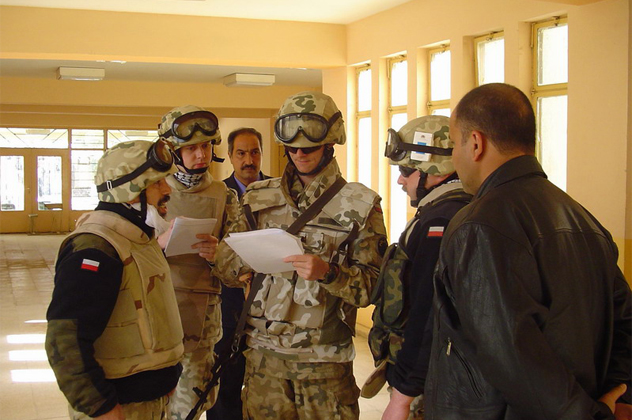 Mysteries
Mysteries  Mysteries
Mysteries  History
History 10 Surprising Stories About the Texas Rangers
 Humans
Humans 10 Philosophers Who Were Driven Mad by Their Own Theories
 Miscellaneous
Miscellaneous 10 Video-Game-Worthy Weapons and Armors from History
 Weird Stuff
Weird Stuff 10 Psychics Who Accurately Predicted Wartime Events
 The Arts
The Arts 10 Pieces of Art Inspired by a Broken Heart
 Health
Health 10 Science Fiction-Sounding New Medical Treatments
 History
History 10 Surprising Facts About the Father of Submarine Warfare
 Space
Space Ten Astonishing New Insights into Alien Worlds
 Weird Stuff
Weird Stuff 10 Bizarre Summer Solstice Rituals Still Practiced Today
 Mysteries
Mysteries Top 10 Haunting Facts About the Ghost Ship MV Alta
 History
History 10 Surprising Stories About the Texas Rangers
 Humans
Humans 10 Philosophers Who Were Driven Mad by Their Own Theories
Who's Behind Listverse?

Jamie Frater
Head Editor
Jamie founded Listverse due to an insatiable desire to share fascinating, obscure, and bizarre facts. He has been a guest speaker on numerous national radio and television stations and is a five time published author.
More About Us Miscellaneous
Miscellaneous 10 Video-Game-Worthy Weapons and Armors from History
 Weird Stuff
Weird Stuff 10 Psychics Who Accurately Predicted Wartime Events
 The Arts
The Arts 10 Pieces of Art Inspired by a Broken Heart
 Health
Health 10 Science Fiction-Sounding New Medical Treatments
 History
History 10 Surprising Facts About the Father of Submarine Warfare
 Space
Space Ten Astonishing New Insights into Alien Worlds
 Weird Stuff
Weird Stuff 10 Bizarre Summer Solstice Rituals Still Practiced Today
10 Vile Ways Psychology Is Used For Evil
Psychology is a discipline meant to help us understand how people think, behave, act, and react to all the various situations that can occur in life. And considering that people are the most important part of our society, this is a pretty important discipline. Unfortunately, psychology isn’t always used for good reasons. Sometimes, the knowledge of psychology is used for evil, and the results are nothing short of sickening.
10 APA Psychologists Reverse Engineer Anti-Interrogation Techniques

The US military has always been concerned about their soldiers being captured behind enemy lines. In order to deal with this problem, they had military psychologists come up with a program to teach soldiers how to resist torture. This program is called SERE, and stands for Survival, Evasion, Resistance, and Escape. Unfortunately, after 9/11, many of the higher-ups in the CIA and the Department of Defense decided that we were the ones who needed to extract information—no matter how it was accomplished.
Enter military psychologists Mitchell and Jessen, who decided that they would reverse engineer the military’s SERE program in order to break detainees. The fruits of their labor have made popular such techniques as stress positions, waterboarding, humiliation, and a host of other ways to break a detainee’s spirit. Much of their work was inspired by the research of one Dr. Seligman, who discovered what he termed “learned helplessness.”
First, he tortured dogs by shocking them with electricity. After they had been subjected to this long enough, they no longer tried to escape the pain—even when they had the opportunity. While Seligman has denied any involvement in the military’s “enhanced interrogation” techniques, his work was certainly an inspiration to those who reverse engineered SERE.
9 PSYOPS Is Tasked With Manipulating US Senators

Most reasonable people understand that, if you’re going to use it, psychological warfare is supposed to be used on your enemies—not on your own people. However, Lt. General William Caldwell had other ideas. This intrepid general decided that he wanted more funding and support for the war in Afghanistan, so he tasked PSYOPS, the army’s psychological warfare division at the time, with using their training to convince visiting senators and VIPs to support the war effort.
The Lt. Colonel who was in charge of the operation felt extremely uncomfortable using his training in a manner that he felt was against the law, not to mention common ethics. However, despite his protests, he and his team were forced to go ahead and start working on their psychological profiles of visiting dignitaries anyway, with the general even considering trying to get into the heads of NATO leaders as well. Eventually, the Lt. Colonel had had enough, and blew the whistle on the operation, leading to a major scandal and an investigation by General Petraeus. But, like many whistle-blowers, Lt. Colonel Holmes—despite having an incredibly stellar record—was brought up on disciplinary charges for tattling on his superior officers.
At least, that’s one version of the story. Details on Caldwell’s specific orders suggest that maybe there weren’t any nefarious psychological persuasion techniques used at all. According to one of the military attorneys who looked into the case, the orders were simply to “gather publicly available information, analyze it, and share the analysis with the visiting politicians.” Perhaps the final “analysis” had some bias that would further the general’s plans to get more soldiers into Afghanistan, but that’s not necessarily illegal—just morally ambiguous. In any case, the full details of what really happened are buried in the muddy waters of military bureaucracy, so we’ll probably never really know the full extent of Caldwell’s little persuasion gimmick.
8 Massive North Korean Brainwashing

Most people know that North Korea is a brutal regime that takes things far beyond the realms of sanity, but they do much more than just oppress their people with force of arms. See, to truly control a populace, you need to control their thoughts, so the leaders of North Korea turned to brainwashing on a truly massive scale.
People may remember the weeping citizens on the news when Kim Jong Il kicked the bucket. Many people thought it was faked by the North Korean government, but one defector who ran off to South Korea more than a decade ago explained that the emotion you saw on TV was genuine. In fact, even after almost a decade, watching the displays of emotion on TV brought her back to her time in North Korea, and made her feel like she believed in his godhood once more. This is brainwashing so powerful that, decades later, those who know the truth still have trouble divorcing themselves from the lies they were once fed.
7 The Social Isolation Of Bradley Manning

Recently, researchers have started to understand just how important social interaction is for the healthy functioning of a human mind. It turns out that humans need to interact with other humans almost as much as we need food and water. Copious research has now shown that extended social isolation, even for just a few months, can easily break a person and cause serious psychological harm. Bradley Manning is well known for blowing the whistle on awful things that the United States was doing in overseas military operations. Even though he had not yet been convicted of anything, and certainly didn’t receive a speedy trial, the military decided that they couldn’t wait for the law before they started punishing him for ratting them out.
For years before he actually stood trial, Manning was kept in solitary confinement and only allowed out of his cell for an hour a day to exercise. He wasn’t offered even the most basic items, like pillows and sheets, and had no contact with the outside world. To make matters worse, the doctors at the prison knew full well that what they were doing could be damaging him psychologically. However, instead of petitioning to give him humane conditions, they just stuffed anti-depressants down his throat so he wouldn’t go completely bonkers before they could finally put him to trial.
6 Sensory Deprivation Experiments

Back in the 1950s, when it was easier to get an unethical experiment past your university’s review board, psychologist Donald Hebb decided to test a pet theory of his. It was Hebb’s belief that if a person was totally deprived of any sensory input at all, their brain would start to weaken and perform less efficiently. To test this theory, he paid students $20 a day to take part in his study. However, even Hebb didn’t entirely anticipate just how awful the results of his experiment would be. Hebb initially thought that he would be able to observe his test subjects for several weeks to get some solid data, but it turned out that none could last even one week.
Now, this was pretty severe sensory deprivation. The test subjects wore frosted goggles, headphones that emitted white noise, and clothing meant to limit their sense of touch. It was found afterward that these people had temporary cognitive impairment even after just a short time with no sensory input, and they were also found to be highly suggestible while deprived. While Hebb’s work would likely be considered unethical now, he had no intention of torturing anyone, and was surprised at how quickly and dramatically his experiment worked.
However, a psychologist by the name of Ewen Cameron was interested in Hebb’s work, and decided to devise his own methods with which to “treat” patients. Hebb wanted no part in this, because Cameron would run his experiments on patients in his hospital who couldn’t really go anywhere, and, after using sensory deprivation and drugs to put them in a suggestible state, would attempt to “reprogram” them. Unsurprisingly, he was eventually sued for methods that Hebb himself referred to as “wicked.”
5 Gaslighting Performed By Psychoanalysts

The term “gaslighting” was originally coined in reference to the movie Gaslight, which involved an abusive husband who was playing a game of psychological warfare against his wife by constantly questioning her version of reality. One of his favorite tricks was to turn down the gaslights in the house, then claim that she was imagining it when she said that the lights had dimmed. This technique is used by abusers to make the other person question their own reality, which in turn makes them much easier to control.
Unfortunately, sometimes those who are learned in the psychological arts decide to use similar dark techniques, and the results are horrifying. In his book, one psychiatrist details a situation in which a doctor created a sort of psychotherapeutic cult, where he sexually abused some of his patients. To make matters worse, this psychologist was also seeing the husband of one woman whom he constantly coerced. The husband would tell the psychiatrist about his worries involving his wife and her involvement with the group, and the doctor would reply that it was the husband who was “distorting his own reality.”
Eventually, people started to come forward with accusations, and the doctor’s reign of terror came to an end—but not before one of his patients almost killed himself from the trauma that the attempted destruction of his reality put him through.
4 Scientology And The Destruction Of Critical Thinking

Scientologists aren’t exactly known for being a kindhearted group of lovely people who just want to make your life better. However, most people don’t know the full scope of how Scientology controls people. See, it’s much more than simply the threat of losing contact with your family, or any of the other methods commonly reported to be used by the church. The true cornerstone of Scientology’s ability to keep others under their thumb is their insidious training program.
The main point of this training program is to keep people from thinking critically about anything involving Scientology. Trainees are made to sit face-to-face with other trainees for long periods of time, without moving or saying anything. They are forced to listen to random passages from Alice in Wonderland—of all things—without laughing or reacting noticeably. Another one of their training techniques is called “bullbaiting,” and involves making a person listen to hostile and abusive things until they react. If they react improperly during any of these training sessions, they flunk and have to start over until they can pass. These combined techniques are designed to make the person believe what they are told without question.
3 Interrogation Through Guilt And Induced Regression

Ever since Dr. Seligman first performed his experiments with dogs, people have been thinking about how they can use his findings to regress people and abuse them mentally for the purpose of extracting information. What the more evil people who read his work figured is that if you treat people the way the dogs were treated in Seligman’s study, you will be able to render their minds more open to suggestion. The idea of “coercive” methods of interrogation is to essentially break down the higher processes of the brain that allow us to plan, think, and take care of ourselves.
In fact, some military documents have suggested that interrogators can use their position of power—and the regressed state of their victims—to guilt them into divulging information. This works because, when they’re tortured and questioned by the same individual for an extended period of time while being kept in a state of learned helplessness, a detainee might eventually start thinking of their torturer as a sort of parent. Once they reach that mindset, the interrogator can then use this weakness to make the detainee feel bad about not telling them what they want to know.
2 False Memories Implanted With Hypnosis

Most psychologists today will tell you that repressed memories are a bunch of pseudoscientific crockery. However, there was a time when discovering “repressed” memories was more common, which caused all sorts of problems for innocent people. Now, we aren’t necessarily saying that the psychologists who helped people recover these alleged memories did so with malicious intent. In fact, many of them probably thought that they were helping their patients. But as we’ve all heard, the road to Hell is paved with good intentions.
One of these mental health professionals discovered allegedly repressed memories that led to first degree murder charges against an innocent person, and ended up dragging that patient into a protracted court battle. The police eventually found that there was not even the slightest shred of evidence that any of the claims made against the man were plausible. While the man did successfully sue, it’s hard to say for certain whether his reputation will ever be the same. While it may seem like a strange case, the unfortunate truth is that implanting false memories is not even that difficult, and we can easily fool ourselves into believing something that never happened.
1 Sensory Overstimulation For Interrogation Purposes

Another technique popular among the “enhanced interrogation” crowd is the reverse of sensory deprivation. According to psychological researchers, subjecting someone to more stimuli than they can handle can be just as effective as taking all stimuli away. These researchers weren’t so much interested in the fact that overstimulating people could be psychologically damaging, but more in how suggestible it made people.
Overstimulation often involves extremely loud noises meant to make it hard for the person to think or react properly to any given situation, but also usually includes repeated rhythms for increased hypnotic effect. Some forms of overstimulation—like Japanese water torture—don’t use sound at all, but instead rely on the fact that your brain needs differing stimuli to continue processing its surroundings in a clear manner. The US military has made use of overstimulation techniques at Guantanamo Bay. These include playing music at extremely high volumes and flashing strobe lights at the detainees. Unfortunately, people don’t generally do well with torture in any form, and these enhanced interrogation techniques have led many of the prisoners to seek an end to their Earthly existence.
You can follow Gregory Myers on Twitter.








